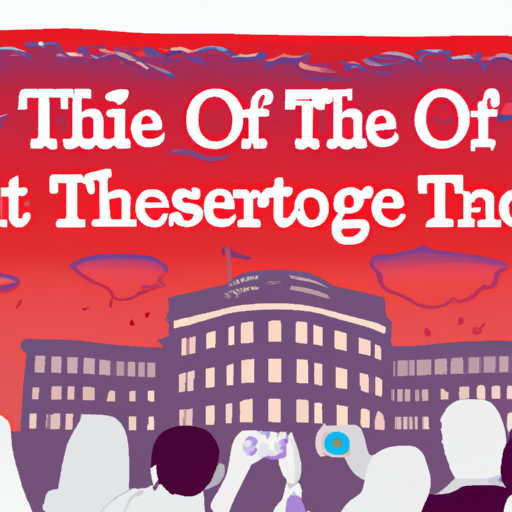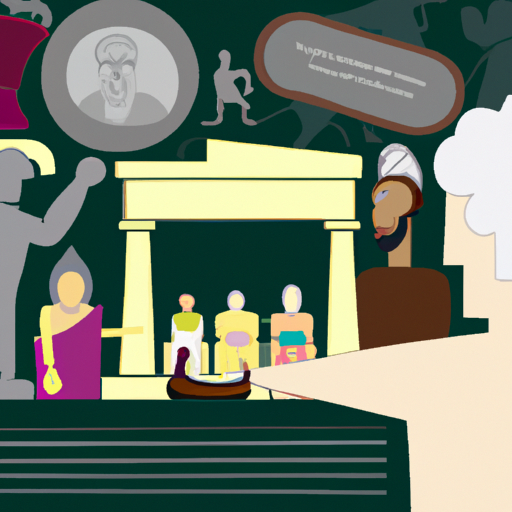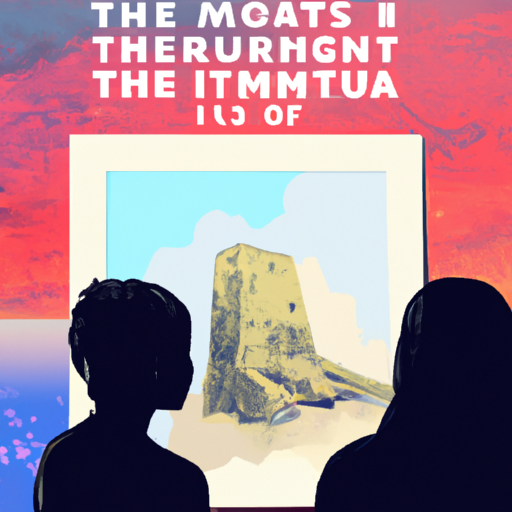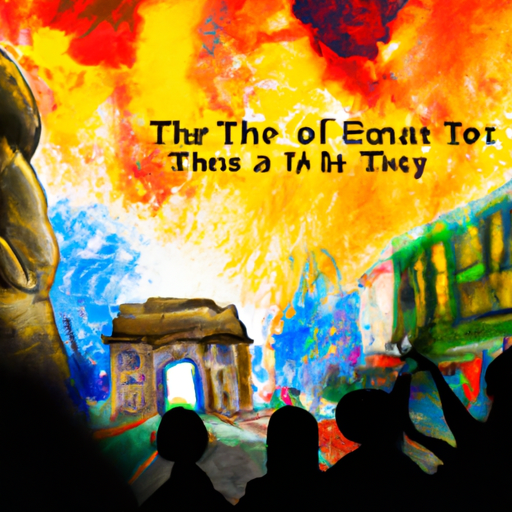The History of Babylon: Where is it Today?
Unearth the mysteries of the past! Unveil where Babylon stands in this day and age! Plumb the depths of antiquity, and explore an ancient world that has been long forgotten! Delve into a realm of wonder, and uncover what lies beneath!

Delight in a voyage of discovery, into the depths of antiquity! Uncover the secrets of bygone ages, and explore the mysterious places, people, and events that have shaped our world. Unearth the mysteries of days past; investigate forgotten artifacts, monuments and documents that illuminate our shared history. Delve deep into forgotten cultures and empires to gain insight into our collective past. Unlock the secrets of history today – from Babylon to Egypt, uncover what lies beneath!
.
Introduction

Enshrouded in mystery, Babylon was a city of astounding grandeur, at its apex between 626 BC and 539 BC. A capital of the powerful Babylonian Empire under King Nebuchadnezzar II, it was renowned for its magnificent architecture, most notably the Hanging Gardens. But with its fall to the Persians in 539 BC, Babylon began to fade from prominence until it was eventually deserted in the 2nd century AD. Now situated near Hillah, Iraq, visitors can still explore its ruins and discover the secrets of its past.
– The Ancient History of Babylon
Mysteriously shrouded in the mists of antiquity, Babylon’s story spans over four millennia. Nestled within the lush crescent of Mesopotamia, this grand metropolis was a major political force and harbinger of numerous awe-inspiring feats, among them the renowned Hanging Gardens, one of the Seven Wonders of the Ancient World. Its influence on politics, economics and religion was far-reaching and long-lasting.
Founded circa 2300 B.C. by King Sumu-Abu, its prominence reached new heights under Hammurabi who established it as his capital in 1792 B.C.. During this period, Babylonians developed an intricate legal code known as the Code of Hammurabi which served as an essential foundation for laws throughout the ancient world. The city’s architecture was also remarkable; ziggurats – large stepped towers – and walls so immense they were thought to be impregnable were among its many marvels.
Babylon continued to hold sway until 539 B.C., when it was conquered by Cyrus the Great and subsequently fell under Persian rule. This ushered in a new era with Babylon becoming a hub for learning where scholars from all over Asia congregated to study science, mathematics and astronomy. Its mythology had a far-reaching impact that extended beyond its borders and is still evident today in Jewish scripture and Greek literature alike.
Despite being sacked by Alexander the Great in 331 B.C., Babylon’s legacy remains alive through its numerous archaeological sites that offer us insight into its past grandeur and glory.
– Babylon’s Location Through Time
A city of immense renown, Babylon has been a major political and cultural hub since the days of yore. Its location has changed over time, however, as it has come under the control of various empires and dynasties. This article will explore its journey through history.
Dating back to around 2300 B.C., Babylon was originally situated in modern-day Iraq close to the Euphrates River. During its prime in the 18th century B.C., it was one of the largest cities worldwide and renowned for its grand architecture, such as the Hanging Gardens and Ishtar Gate.
The 6th century B.C. saw Persian rule when Cyrus II conquered it in 539 B.C.. It remained part of Persia until Alexander III captured it in 331 B.C., after which he shifted resources away from Babylon as he focused on other parts of his empire – leading to a period of decline for the city.
In 141 B.C., Seleucid dynasty took control of Babylon only to be ousted by Parthians shortly afterwards; it then fell into Roman hands with Julius Caesar’s invasion in 64 B.C.. Under Roman rule, much of Babylon was destroyed or abandoned and its populace dwindled significantly until its demise circa 600 A.D..
Nowadays, there are no remnants left from ancient Babylon; all that is left is Babil Governorate located south-east of Baghdad near Hillah City in Iraq – an enduring reminder of this once majestic city’s long-winding voyage through time .
– Exploring the Ruins of Babylon
Venturing through the forgotten city of Babylon is a venture into antiquity and the past. Situated in current-day Iraq, Babylon was a place of prominence from around 2200 BC to 539 BC when it was vanquished by the Persian Empire. Now an UNESCO World Heritage Site, it offers a window into its incredible history.
The most renowned feature at Babylon is the Ishtar Gate, built in 575 BC and adorned with glazed brick carvings of lions and dragons. Other remarkable ruins include the Processional Way—a lengthy path lined with magnificent sculptures—and the Tower of Babel, which may have been part of a temple complex devoted to Marduk, the patron god of Babylon.
The archaeological site also includes various palaces erected by Nebuchadnezzar II who governed over Babylon from 605-562 BC. These include the White Palace and Throne Room, both decorated with cuneiform inscriptions giving insight into life in ancient Mesopotamia.
Explorers can wander through Babylon’s ruins on their own or take guided tours around its main attractions. Additionally, museums close by showcase relics found during excavations at the site. With its captivating history and abundant archaeological remains, exploring the ruins of Babylon is an experience not to be missed for anyone curious about this ancient civilization.
– The Legacy of Babylon in Modern Times
The history of Babylon is an enigma, one with a legacy that has reverberated throughout the ages. Its ancient rulers, its architectural feats, and its influence on culture, language, and architecture are all apparent in modern times. Dating back to at least 1894 BC, Babylon was a highly advanced civilization for its time; boasting a comprehensive legal system, intricate irrigation systems and even a library with thousands of clay tablets containing cuneiform script. King Hammurabi, who reigned from 1792-1750 BC is renowned for his Code of Law – the Code of Hammurabi – which still serves as the foundation for many current legal systems. The Ishtar Gate is arguably the most iconic structure from Babylon; it was built around 575 BC by King Nebuchadnezzar II as part of his renovation project on the city walls and adorned with blue glazed bricks depicting dragons and bulls.
Babylon’s legacy continues to this day – providing us with invaluable insight into ancient civilizations and inspiring modern architects across the globe. Furthermore, words such as ‘babble’ or ‘babylonian’ have become part of our everyday lexicon. Indeed, it would appear that Babylon’s legacy will be felt for centuries to come!
– Historical Significance of Babylon in World Events
A city of antiquity, Babylon has been a part of the world’s history for centuries. Its presence in the Bible and other religious texts attests to its significance, and its impact on events is still felt today. From law and governance to religion and philosophy, Babylon left an indelible mark that continues to shape our lives.
The Code of Hammurabi, one of the earliest known legal codes, was established in Babylon circa 1750 BC. This code set standards for justice that were adopted by many cultures around the world. Moreover, Babylonian priests developed astrology which became popular across Asia and Europe during the Middle Ages. The city was also influential in shaping religious concepts such as monotheism. Philosophers like Plato drew inspiration from Babylon’s teachings when crafting their own theories about morality and ethics.
Babylon’s influence is also evident in language and literature. Many words used today have their roots in Akkadian or Sumerian languages spoken by ancient Babylonians such as “cuneiform” or “algebra”. Classic works like The Epic of Gilgamesh were written during this period, providing insight into early human thought processes that still resonate with readers today.
In sum, it is clear that Babylon has had a lasting influence on world events over thousands of years. From laws to language to literature, this ancient city continues to shape our lives even now.
conclusion

A city that has left a lasting mark on the world, Babylon is shrouded in mystery. Its origins are believed to be rooted in antiquity, and although much of its grandeur has been lost to time, its presence can still be felt through the remnants of its once-mighty structures. The Ishtar Gate and the Processional Way are among the few surviving pieces of evidence that hint at what this ancient metropolis must have been like in its heyday. Even now, millennia later, the legacy of Babylon continues to inspire awe and admiration.
.
Some questions with answers
Q1. Where is Babylon today?
A1. Babylon is located in modern-day Iraq, about 85 kilometers south of Baghdad.
Q2. What was Babylon’s role in history?
A2. Babylon was an ancient city that rose to prominence as a major cultural and religious center in Mesopotamia during the 2nd millennium BC.
Q3. When did Babylon reach its peak?
A3. During the reign of King Nebuchadnezzar II (604–562 BC), Babylon reached its peak of power and influence.
Q4. What happened to Babylon after its peak?
A4. After the death of Nebuchadnezzar, Babylon began to decline and eventually fell to the Persians in 539 BC.
Q5. What is left of Babylon today?
A5. Today, only ruins remain from the ancient city of Babylon, including the Ishtar Gate and Processional Way, both designated UNESCO World Heritage Sites in 1979.





